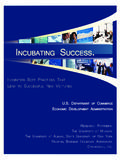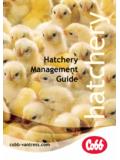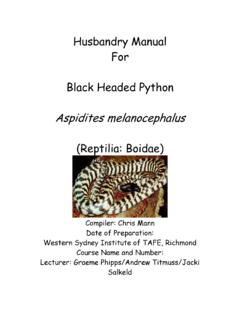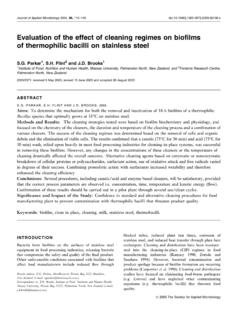Transcription of Efficacy of garlic (Allium sativum) extract applied as …
1 Efficacy of garlic (Allium sativum) extract applied as atherapeutic immersion treatment in aquacultureT A Militz, P C Southgate, A G Carton and K S HutsonCentre for Sustainable Tropical Fisheries and Aquaculture and the School of Marine and Tropical Biology, JamesCook University, Townsville, QLD, AustraliaAbstractGarlic,Allium sativumL., extract administeredas a therapeutic bath was shown to haveantiparasitic properties towardsNeobenedeniasp. (MacCallum) (Platyhelminthes: Monogenea)infecting farmed barramundi,Lates calcarifer(Bloch).The effect of garlic extract (active com-ponent allicin) immersion development, hatching success, oncomiracidia(larvae) longevity, infection success and juvenileNeobenedeniasurvival was examined and com-pared with freshwater and formalin extract was found to significantly impedehatching success (5% 5%) and oncomiracidialongevity (<2 h) at allicin concentrations 1, while eggs in the seawater controlhad>95% hatching success and mean oncomirac-idia longevity of 37 3 h.
2 At much lower alli-cin concentrations ( and 1), garlicextract also significantly reducedNeobenedeniainfection success ofL. calcariferto 25% 4%and 11% 4%, respectively, compared with55% 7% in the seawater control. JuvenileNeobenedeniaattached to host fish proved to behighly resistant to allicin with 96% surviving 1-himmersion in 10 mL L 1( 1allicin)of garlic extract . Allicin-containing garlic extractsshow potential for development as a therapy tomanage monogenean infections in intensiveaquaculture with the greatest impact at the eggand larval :allicin, aquaculture, garlic , Monogenea, neobenedenia , parasite (MacCallum) (Monogenea: Capsali-dae) are marine ectoparasites of finfish knownfor their ability to cause major epizootics in mari-culture (Bondad-Reantasoet ; Deveney,Chisholm & Whittington 2001; Yamamotoet ).
3 Neobenedeniagraze on host epithelialtissues, causing lesions and haemorrhaging (Hiraz-awaet ; Whittington 2012). While feed-ing, adultNeobenedeniacontinuously oviposit eggsthat hatch into infectious, free-swimming oncomi-racidia (larvae), capable of directly re-infecting theprimary fish host. This parasite s direct life cycle,along with short generation times and broad hostsusceptibility, causes difficulties in managinginfections and has severely limited the expansionof mariculture ( Seng 1997; Hirazawaet ; Liaoet ).Management ofNeobenedeniainfections primar-ily relies on reactive treatments as opposed toproactive preventative management strategies. Theestablished methods of treatment involve recurrentacute bathing of infected stock primarily in eitherformalin or freshwater solutions (Kanekoet ; Thoney & Hargis 1991; Fajer- Avilaet ).
4 While these treatments kill attachedNeo-benedeniajuveniles and adults, eggs are generallyresistant and can exist outside the treatment area(Mueller, Watanabe & Head 1992; Ellis &Watanabe 1993). The physiological strain placedon the host during such treatments significantlyCorrespondenceT A Militz, Marine Parasitology Laboratory,School of Marine and Tropical Biology, James Cook University,QLD, Australia (e-mail: 2013 John Wiley & Sons LtdJournal of Fish Diseases2013 susceptibility to re-infection (Ohno,Kawano & Hirazawa 2009). Furthermore, the useof formalin is complicated by the potential forenvironmental impacts and harm to human health(Masters 2004; Woosteret ). Conse-quently, the development of alternative controlmeasures to prevent or reduce the intensity ofNeobenedeniaoutbreaks is highly research interest has been directedtowards antimicrobial plant-based phytochemicalsfor preventative parasite management, many ofwhich are without the negative side effects associ-ated with synthetic drugs (Palavesam, Sheeja &Immanuel 2006; Immanuelet ; Hutsonet ).)
5 Allicin, a phytochemical agent of gar-lic,Allium sativumL., is a promising antiparasiticcompound demonstrating selective toxicity towardsmicrobes (Rabinkovet ; Davis 2005). Inaquaculture, garlic has been demonstrated to exhi-bit antibacterial activity against a number of patho-genic bacteria of freshwater fish, but only a fewreports describe the use of garlic extracts for man-agement of parasitic diseases in fish (Lee & Gao2012). garlic extracts have previously beenreported to eradicate ectoparasitic trichodinidswhere formalin proved ineffective (Madsen, Buch-mann & Mellergaard 2000) and has demonstratedin vitrotoxicity towards aquaculture significantprotozoan parasites ( multifiliis[Fouquet],see Buchmann, Jensen & Kruse 2003;Spironucleus vortens[Poynton, Fraser, Francis-Floyd, Rutledge, Reed & Nerad], see Milletet ;Neoparamoeba pemaquidensis[Page], see Pey-ghan, Powell & Zadkarami 2008).
6 The usefulnessof garlic for the management of more complexmetazoan parasites has only recently been explored(see Abd El-Galil & Aboelhadid 2012), and furtherstudies assessing prospects of garlic therapy formanaging metazoans are study investigates the use of an allicin-con-taining garlic extract as a therapeutic immersion or bathing treatment against all life stages ofNeobene-deniasp. using the commercial host barramundi,Lates calcarifer(Bloch), as a model to determine thepotential of garlic in ectoparasite and methodsGarlic extractGarlic (variety Glen Large) grown in Queensland,Australia, was freshly peeled and homogenizedwith H2O at a ratio of 5 mL per 1 g for 60 homogenate was allowed to stand for 5 minwithout agitation before being filtered through a90-lm screen and Whatman no.
7 1 filter in succes-sion to produce the garlic extract . Stock solutionsof the garlic extract were stored at 4 C until useand used within 1 month. Prior to each experi-ment, a sample of the extract was removed andfiltered to , and the allicin content wasdetermined by high-performance liquid chroma-tography (HPLC).Determination of the garlic extract s allicincontent was carried out using an applied Biosys-tems SPERI-5 C18 250 mm column(5lm bead size) with a methanol and water(50:50) mobile phase run at a flow rate mL min 1. An injection volume of 100lLwas used, and peaks were detected at 254 nm andrecorded by a Varian Pro Star UV-visible recor-der. An aqueous solution of pure (>98%) allicinwas created using previous methods (Lawson &Wang 2001) and used as the HPLC standard forallicin quantification.
8 The concentration of allicinpresent in the garlic extract was determined to 1across all four concentrations of the garlic extractexamined for their therapeutic effect againstNeobenedeniasp. are shown in Table of fish andNeobenedeniaThe experimental hostL. calcariferwere juvenile(100 200 mm) freshwater hatchery-reared fishobtained from a local nursery in Queensland,Australia. Naivety to parasitic infections was con-firmed through hatchery records and by visuallyinspecting 10% of the experimental stock, anaes-thetized with AQUI-S, under a stereomicroscopeprior to eggs were ini-tially collected from an inland, marineL. calcariferfarm in Queensland, Australia. Filamentous algaecontainingNeobenedeniasp. eggs were removedTable 1 The four garlic ,Allium sativum, extract concentrationsassessed for their therapeutic effect onNeobenedeniaGarlic extract concentration mL L 1 Allicin contentlLL of Fish Diseases2013T A Militzet extract therapeutic immersion 2013 John Wiley & Sons Ltdfrom infected raceways and maintained in seawater (35 g L 1) until the onset of hatched (<6 h post-hatch) oncomiracidiawere introduced to naiveL.
9 Calcarifermaintainedin 20-L non-renewal aquaria (35 g L 1,25 C).The species ofNeobenedeniainvestigated in thisstudy (hereafter asNeobenedenia) is presentlyunidentified given the absence of diagnostic crite-ria to differentiate between geographical/host iso-lates and species pending a revision of the genus(Whittington 2012). Representative adult speci-mens were accessioned in the Australian HelminthCollection, South Australian Museum, Australia(SAMA AHC 35461).NeobenedeniaeggsThe Efficacy of acute and continuous garlicextract immersion therapy for the prevention ofNeobenedeniaembryo development and hatchingsuccess was investigated. These effects were com-pared against embryo development and hatchingin commercially applied treatment (freshwaterand formalin) regimes and a seawater control(35 g L 1).
10 Bundles of ovipositedNeobenedeniaeggs were collected by isolating infected barra-mundi in a 5-L aquarium with UV-filtered seawater (35 g L 1) for 12 h. Eggs were collectedby filtering the sea water through a 60-lm filterscreen and backwashing the filtrate into acollection dish. Eggs were carefully separated,and between 15 and 20 eggs were allocated toan individual replicate glass cavity block (40mm2).Each cavity block was randomly allocated toone of two experiments: acute 1-h immersion orcontinuous immersion . Within each experiment,cavity blocks were randomly allocated one ofseven treatment solutions including the seawatercontrol, formalin, freshwater, or 1, 2, 10 and20 mL L 1concentrations of garlic extract . For-malin concentration differed between the twoexperiments following the general guidelines foracute (100lLL 1) and continuous (20lLL 1)formalin treatment of ectoparasites (Noga 2010).







